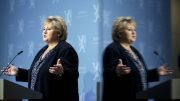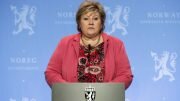The outbreak of COVID-19 is serious for life and health. To counter the outbreak, strong infection control measures have been taken in Norway as well as in other parts of the world. The outbreak will have a major impact on the economy and significantly weigh on economic activity. The uncertainty is huge.
The Norwegian government has introduced significant measures to support jobs, help businesses and people, and strengthen health services. Still, more may be needed in the coming weeks. The measures must be targeted, effective and reversible.
Norwegian measures have been introduced in several steps, with previous proposals to the parliament (Stortinget) on March 13 and March 20. There is broad political cooperation between the Government and the other parties in Stortinget.
On 27 March, the Government proposed further measures to Stortinget, including a new scheme for cash pay-outs to otherwise sustainable businesses that are severely affected by measures to contain the pandemic.
The fiscal measures so far, excluding the cash pay-out scheme mentioned above, add up to over NOK 75 billion (Table 1 below), corresponding to around 2.4 percent of Mainland GDP. The new cash pay-outs to businesses may increase the non-oil budget deficit by another 10-20 billion NOK per month the scheme is in operation.
The budget is estimated to be further weakened by close to NOK 60 billion by reduced tax revenues and higher expenses due to the economic downturn (automatic stabilizers). Overall, the oil-adjusted budget balance is estimated to be weakened by more than NOK 135 billion in 2020. These estimates are based on assumptions that corresponds to the GDP for Mainland-Norway contracting by around 2 percent in 2020.
In addition, the guarantee schemes for SMEs and the Government Bond Fund contributes with at least NOK 100 billion. Reduced key interest rates also contribute to households and business liquidity thorough lower lending and deposit rates.
Measures adopted and proposed to mitigate economic effects of Covid-19 include:
Measures aimed at business and industries
- The employer-paid days are reduced from 15 to 2 days for temporary lay-offs, from 10 to 3 days for care-related leave and for corona-related sick leave the employer-paid days are reduced from 16 to 3 days.
- A new broad scheme for cash support to otherwise sustainable businesses that are severely affected by measures to contain the pandemic. Companies may be compensated for a part of their fixed expenditures, like rent, debt servicing and insurance. Businesses that have been instructed by government decisions to close down will get the highest compensation. The duration of this measure is currently two months.
- Companies that make a loss can re-allocate up to NOK 30 million of the tax loss against surplus from 2018 and 2019
- Deadlines for payment of value added tax, employer tax and payment of advance tax for self-employed and companies are postponed.
- The low VAT rate, which includes passenger transport, accommodation and parts of the cultural sector, is reduced from 12 to 8 per cent.
Airlines-related measures include:
- Suspension of the tax on air passengers, for flights in the period from 1 January until 31 October 2020.
- Suspension of payments of aviation charges.
- Purchase of domestic air routes where there is no basis for commercial operations due to the crisis.
- Introduction of an aviation guarantee scheme totalling NOK 6 billion, with a 90 percent government guarantee on each loan. Of these, NOK 3 billion is directed to Norwegian Air Shuttle, 1.5 billion to SAS and the remaining 1.5 billion to Widerøe and other airlines.
- Increased funding for Innovation Norway and the Research Council by a total of around NOK 3.8 billion, and NOK 1 billion increased investment capital in Investinor.
- Pre- and after school cares and day cares are compensated for income loss.
- A compensation scheme of NOK 900 million for culture, sport and voluntary sectors.
Guarantee and loan schemes for businesses
- In the state guarantee scheme for bank loans to small and medium-sized enterprises the state guarantees 90 per cent of the loans within a total guarantee framework of NOK 50 billion. The scheme is planned to enters into force on Friday, March 27, after approval from ESA is available and rules for the scheme are laid down in regulations.
- The Government Bond Fund shall increase liquidity and access to capital in the Norwegian bond market, and is aimed at larger companies. The investment budget is NOK 50 billion.
- Increase borrowing limit in Innovation Norway’s loans scheme by NOK 1.6 billion.
- Increase funding for business-oriented research and development by NOK 250 million.
Measures aimed at persons
- Unemployment benefit are granted from the first day and the daily allowance increased. Temporary laid off persons are guaranteed 100 per cent compensation until a salary of 599 148 NOK for the first 20 days. The schemes for temporary laid off and unemployed are adjusted to include more people. The entitlement period are proposed extended to 30 June.
- A temporary scheme to secure self-employed and freelancers who are not included in the unemployment benefit scheme and to give self-employed and freelancers sickness benefit from day four.
- To establish a temporary benefit scheme based on social assistance rates for persons outside the EU / EEA area staying in Svalbard.
- To double the number of days parents can stay home with sick children, and to permit transfer of days between co-parents.
- To entitle self-employed and freelancers to the same number of sick-kids days as employees, less a three-day waiting period.
- Increased access to loans for students
- Parents do not pay for pre- and after school cares and day cares during the period they are closed.
Table 1. Estimated changes in non-oil Fiscal Budget deficit for 2020 as a result of economic measures and changed outlook for the economy. Billion NOK.
| 2020 | |
| Mitigating income loss for businesses1 | 30.7 |
| Mitigating income loss for persons | 20.8 |
| Critical sectors2 | 1.1 |
| Other compensation schemes | 5.5 |
| Aviation sector, including loss provision to guarantee scheme | 8.7 |
| Loss provisioning, government guarantees for bank loans to business | 10.0 |
| SUM Discretionary measures | 76,8 |
| Automatic stabilizers | 59.0 |
| Reduced tax revenue3 | 37.0 |
| Increased expenditure on unemployment benefits | 18.0 |
| Increased sickness allowance | 4.0 |
| SUM Weakening of the budget balance | 135.8 |
1 The new cost-mitigating scheme for companies is not included.
2 Health- and social services have been given permission to exceed their budgets.
3 Includes increased taxes due to the extensions of the unemployment benefit scheme and new income protection schemes for self-employed and freelancers.
Source: Ministry of Finance






Be the first to comment on "Economic measures in Norway in response to COVID-19"